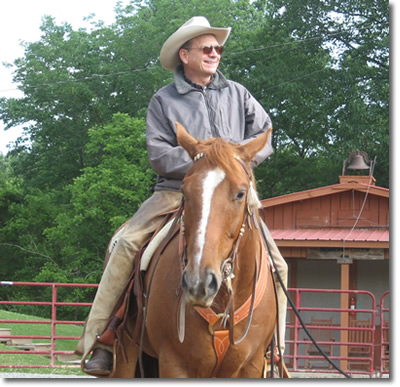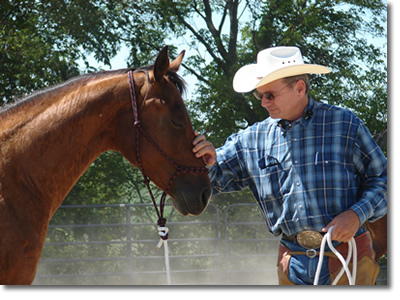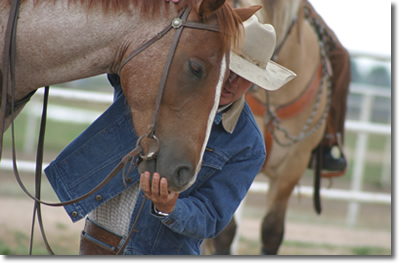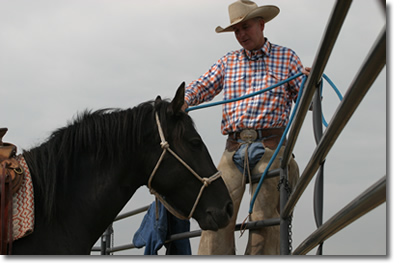Written by Tom Moates
Picking the right trail horse is never a trivial consideration. It is a very important decision and packs plenty of gravity for anyone. A good fit between horse and rider makes all the difference between many enjoyable trail riding experiences, or, well…the opposite.
Lacking experience with horses makes the job doubly difficult. If you aren’t confident in your own equestrian savoir-faire, then finding good advice on how to find the right trail horse for yourself can be just as difficult as finding the right horse in the first place.
Horsemanship clinicians travel the country and see as many varied horses, riders, problems, and achievements as anyone. Here, we’ve wrangled two celebrated clinicians and put to them the question of what a person might do to find the right trail horse if in the market for one. The candid discussion produced some indispensable insights, and hopefully some of these tips will better your chances of finding that perfect trail horse.
Harry Whitney
www.HarryWhitney.com
Based in: Salome, Arizona

Harry Whitney is renowned for “seeing things from the horse’s point of view.” The rodeo circuit was where he honed the horsemanship and animal training talents that later became the basis for the clinic work he’s conducted continually across America each year for more than two decades.
“If I was going to check out a trail horse to buy,” Harry says, “I would try to figure out a way to meet the people in an unfamiliar spot to them and their horse to test him. People always say, ‘Well come by and look at him.’ Which there’s nothing wrong with going by and looking at him, but before you bought him I would want to meet them at some park where you could ride, or a trail head of some kind where he’s never been. Maybe you don’t have anything in the area where he’s never been if they do a lot of trail riding, but at least take him away from home, and by himself. See how he acts without another horse and in an environment other than his home, and then you can take him down the trail a little ways a test him out.”
Harry’s advice provides the chance not only to see a horse in a real trail ride environment before you buy him, but also provides the added opportunity to detect if the horse is herd bound. If the sellers can show up to an unfamiliar spot with the horse alone, and he behaves calmly and you can ride him a bit and be comfortable in the saddle, that is a good start towards finding the right horse for yourself. Likewise, you ought to start seeing some trouble in this scenario if the horse isn’t going to be okay with it. Even if the above situation goes well, Harry cautions: “Stick around till they reload him. If you meet somewhere, don’t jump in your car and rip out after you ridden him until he’s back inside the trailer. Tell them that you want to see him loaded.”
“Something to avoid,” Harry says, “is when they [the sellers] say, ‘A young horse that will make a great trail horse.’ Yeah, there’s a lot of them that have the potential…they could if you want to put the time and work into it, but I want to direct people towards one that is—not will be, or could be.”
Harry also suggests steering clear of horse sales, or at the very least to be dubious of what you are told about horses in them. Base your decision on a first hand assessment of a horse if you consider buying at a sale.
“I would say feet would be the biggest issue,” Harry explains when asked about what confirmation to look for in a trail horse. “I don’t know how technical you’d want to get on something like that, but you could talk to a good farrier or one of the natural trim people and get some thoughts on how to look for a good foot. But, you know you sure wouldn’t want to have somebody sell you a pretty trail horse that they’ve shown it in a few trail classes at a show, but has got these little tiny feet like a halter horse and it’s never going to hold up out there really riding in rough country.

“Soundness issues on checking out a horse…that’s a different deal,” he continues. “They should have a vet check. A vet check should be a reasonable thing. If you do a vet check, you’re better off to either get your vet, or a vet that is neutral, not their vet.”
“I hate to tell a story…” Harry continues, “but, somebody was just telling me about trying to sell a horse, and the people came and rode it, and it would just go anywhere, do anything, walk, trot, lope. Just real gentle and quiet. After they’d ridden it and everything, they said, well, they were looking for something with a little more ‘go’ to it. And, they weren’t that experienced riders. They thought that the horse was calmer and quieter than they wanted.
“My thought is, a good experienced rider can bring a horse up to their standards, but to bring a more hyper-active, lively horse back down to someone’s level who has less experience is a whole different deal. So, I would always say get something that maybe you felt like was for somebody a little less advanced than you were, and you could catch the horse up. Or, you could always trade out and go to another horse. It’s worth trying and looking at a horse that seems a little less than what you thought you wanted than to have too much.”
Bryan Neubert
www.BryanNeubert.com
Based in: Alturas, California

Bryan Neubert travels the country part of each year conducting horsemanship, colt starting, and cow working clinics, and works with problem horses and starts colts when at home from the road. Several videos showcasing his teaching are available including, Wild Horse Handling and The First Week (with clinician Joe Wolter, and his son Jim Neubert).
“For a big part of my life I was a ranch cowboy,” says Bryan when asked about picking the right trail horse. “I was the boss on some ranches where I could pick through a hundred head of horses and pick my string. The boss usually puts on the biggest circles [distances gathering cattle]. There’s a few things there that are just real important to me. The first thing is endurance. I don’t want to be riding something that I got to be poking on to get him home. This is either something they’re born with or their not, as far as I know. You can help one to get more responsive, but it makes quite a lot of difference in how tired you are at the end of the day if you’ve had one that’s kinda wanting to roll right out and go, or one you’ve got to peck on all the time. So the number one thing I think about is having a horse that’s got the guts, that’s wanting to stay lively throughout the day without getting tired.”
Bryan’s experiences as a cowboy are much like that of a trail rider putting in long days, he figures. Choosing a great many horses for the job over the years provided an intensive opportunity to determine what equine attributes work best in that setting. Selecting mounts from a group of ranch horses allowed him the chance to view his prospects in a herd in an open area. Such an opportunity may present itself to you when looking for your trail horse, allowing you to apply his outlook similarly. If not, his advice still addresses what he finds to be the most desirable characteristics in a horse you would want for logging longer days on the trail.
“The second thing that I look for that’s real important is smoothness of gait,” Bryan says. “Which is another thing I don’t know how to affect, they’re either rough or they’re smooth. It’s probably got a lot to do with the shape of their shoulder and pastern and all the joints that make it smoother. When I was younger, I probably would pick endurance over smoothness of gait, and maybe now I’d pick smoothness of gait over endurance.
“In watching just a bunch of loose horses traveling,” Bryan explains, “the back is smoother and the horse has got a lot of spring [showing smoothness of gait]. Or if they hit the ground kind of hard–well they’re gonna be kinda hard to ride. You don’t even have to put a halter on them to see that. If I was picking through a bunch of horses, that’s one thing I’m really gonna look for.
“If horses are just kind of moving—well, my own horses, I’ve got probably twenty head of horses turned out at home now, and when I wrangle, that means you go out to get them, there’s horses that are always up in the lead and there’s horses that are always dragging in the back. And those ones that are in the lead, a lot of times when you’re riding them they’re brisk and lively, and the ones that are always in the drag, they’re kinda that way when you’re riding them too. So a horse that’s got kind of a dumpy stride about him, you can just tell it’s not going to feel that great when you’re riding him either. But one that’s alive and sparky when he’s just walking out without a rider, usually that carries over when you’re on their back. If that’s in there naturally it’s kinda nice. There’s things you can do to help them be perked up, but it’s nice when they’re born with it. It makes such a difference if you’ve got very many miles to go. It’s like night and day difference.”
Bryan’s experience as a clinician likewise provides some insight on what to look for in a capable trail horse. When conducting clinics he sometimes asks if anyone’s horse has trouble loading.

“And there won’t be anybody say anything,” he explains. “But then I notice they’re having a hard time getting them through a gate, and I’m thinking, ‘And that horse goes into a trailer good?’ They can’t get in the trailer unless the go forward, and they can’t go forward unless they kinda trust your judgment a little bit. Will he come willingly forward when I ask him to? That relates to water and ditches and any kind of thing you might encounter on the trail. You can’t really have a trail horse unless he will load, but you can’t really load him unless you can catch him.
“When I’ve started horses for people, if they said they would be here at eleven, I would try to be ready and mounted for them at quarter to eleven. But then I got to thinking, if I’ve got him nice to catch, I want to show it to them. So I’ll be riding something else when they pull in the yard, and go tie that horse up, and go catch their horse. Then they can see him caught out in a lot with a bunch of other horses. They can see him saddled and mounted. How much warm up I do, and everything. I get a better chance to show off what I’ve done. That way, a month later they can’t say, ‘I wonder if he even had that horse good to catch, because I can’t catch him now…that’s why he had him caught before I got there.’ So I want to make sure they see it.”
The advice works both ways. Bryan explains it from the point of view of the trainer/seller, but the buyer likewise can ask the seller go through those motions while observing to better determine how the horse is to catch, saddle, load, or even simply come forward with confidence. Another observation and bit of advice from Bryan comes from a rather funny place.
“I was watching America’s Funniest Home Videos one time,” he chuckles, “and this woman has got a wedding dress on, and they’re mounting her up on this black horse, but the horse is just looking back at them with his ears back and pretty nervous, but nobody notices it. And so she’s got this big veil, and as soon as she untracked him, he whipped her back and took off and runs back in the barn door, and you hear a big crash inside the barn. But nobody there saw what was coming. They knew he was probably a horse that was gentle to ride without a wedding veil. That’s the same way with quite a lot of other things…. A person may want to pack a camera, or their lunch hanging off of the saddle horn, or something like that.”
Bryan suggests figuring out a way to check on some of these things when looking at a horse to buy. If you are familiar with using a flag, you might see how the horse reacts to being flagged. If you have your camera handy, you might just approach the horse with it and see how he does. Of course, you don’t want to spook a horse and have him run through a fence, or otherwise cause a wreck, but you ought to be able to assess if the horse is familiar or bothered by some things you will want to use on the trail. A rain slicker is another one he mentions that can be tough for some horses. The example of the video shows also that keeping a close eye on the horse can provide clues to his reactions to things. Keep a lookout for even small things that make the horse nervous or unsettled.
[ux_custom_products cat=”magazine-subscriptions” products=”” columns=”4″ title=”Subscription Options”]


